We're here to answer all your questions about getting prepped for winter driving.
It’s winter, and a chilly storm has brought fresh snowfall to the San Bernardino Mountains. Opportunities abound for skiing, snowshoeing, and tubing making a getaway to Big Bear Lake an absolute must. While you’re planning for fun, it’s important to consider the realities of traveling in winter conditions.
Sourced from: https://dot.ca.gov/
Yes. You will need to carry tire chains in your vehicle from November 1 to April 30 whether or not you actually use them. When CalTrans calls for chain restrictions, you will need to adhere to chain requirements. See Question 12 for levels of chain control.
"As defined in Section 605 of the California Vehicle Code (CVC), tire traction devices are designed to improve vehicle traction, braking, and cornering upon snow or ice-covered surfaces. "
Road conditions and chain restrictions can be found on the Caltrans Quickmaps website. It is recommended that you stay up to date with road conditions as they can change quickly and without warning. Check all boxes under Options then Road Conditions for complete info.
Check your vehicle's owner manual and your tires for specifications on tire chains. It’s important to buy chains or other traction that are the correct size for your tires. Link-type chains that are too big will bang against the body of your vehicle causing significant damage. Chains and other traction that are too small won’t fit around the tire at all.
Chains are sold at most auto supply shops, hardware stores, and some convenience stores. Call the store ahead of time to check the type of chains they carry. Stock sells out quickly when snowy conditions exist and a vast majority of stores only sell chains and will not rent.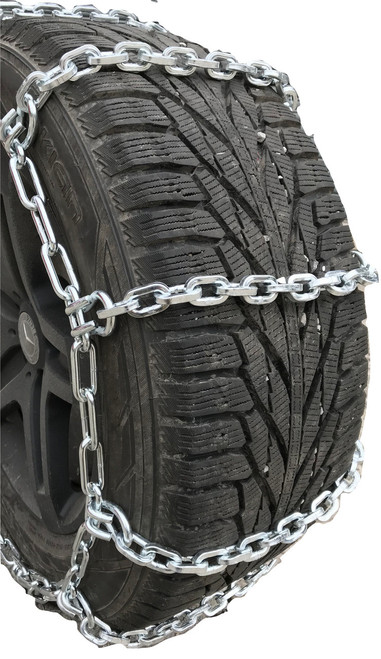 Purchase chains before heading to mountain regions!
Purchase chains before heading to mountain regions!
Apart from link-type tire chains, Alternative Traction Devices include metal cable chains, plastic or vinyl hub cap anchored devices, and other synthetic materials like AutoSocks. It’s important to refer to your vehicle’s manufacturer guide for guidance on chain/traction sizing and specifications. Caltrans and California Highway Patrol reserve the right to prohibit any vehicle from entering a chain control area if it’s determined that traction devices do not meet CVC, Section 605 requirements.
Chains and traction devices need to be installed on the wheels of your drive axle. Refer to your vehicle guide to determine if your vehicle is front axle or rear axle drive. All-wheel drive vehicles and 4-wheel drive vehicles may have chains installed on either drive axle, but the rear axle is preferred unless the vehicle manufacturer recommends the front axle.
The instructions in your tire chain kit will give you a step by step. However, if you’re a visual learner, YouTube has some great, easy-to-follow, tutorials.
Generally, 20 to 30 mph is the recommended speed limit for driving with snow chains. This helps prevent chains from breaking and from potentially damaging your vehicle. Do not drive on dry roads with chains as it can significantly wear down both the chains and your tire tread.
8. Can studded tires and snow tires replace the need to carry/install chains?No. Though studded tires are legal in California from Nov. 1 until Apr. 30 each year, studded tires are not considered tire traction devices and may not be used in lieu of chains. Snow tires have the designation “Mud & Snow” or an abbreviation such as “M-S,” “M+S,” or “M/S” marked on the tire sidewall. Tires without this designation are not considered snow tires.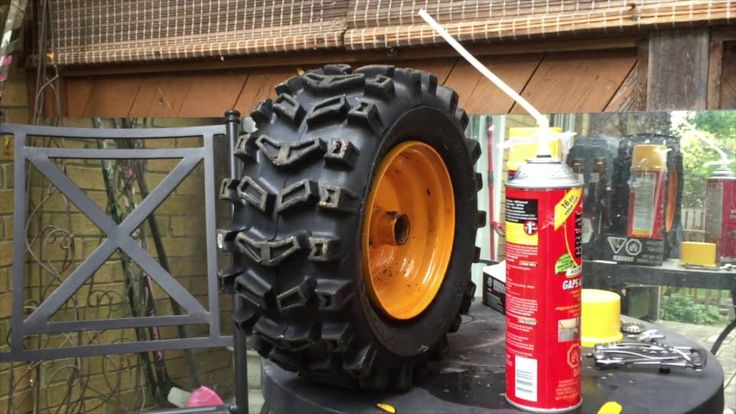 Snow tires must also have at least 6/32-inch (3/16”) of tread depth (about 1/2 of the original tread depth). Same as studded tires, snow tires may not be used in lieu of chains.
Snow tires must also have at least 6/32-inch (3/16”) of tread depth (about 1/2 of the original tread depth). Same as studded tires, snow tires may not be used in lieu of chains.
No. Some car rental companies may not allow chains on their inventory for various reasons, however this does not excuse you from carrying them or installing them if Caltrans requires it. The best bet if you’re worried about snowy roads is to rent either an all-wheel drive or 4-wheel drive vehicle for your journey.
Yes. Many vehicles that don't accommodate conventional link-type chains may accommodate Alternative Traction Devices. Bottom line, if chain control is in effect, you must comply for your safety and the safety of others.
 Do I need chains?
Do I need chains?You need to use chains if you’re towing a trailer. If the trailer has brakes, you must have at least one axle chained.
R1: Chains are required on all vehicles except passenger vehicles and light-duty trucks under 6,000 pounds gross weight and equipped with snow tires on at least two drive wheels. Chains must be carried by vehicles using snow tires. All vehicles towing trailers must have chains on one drive axle. Trailers with brakes must have chains on at least one axle.
R2: Chains are required on all vehicles except four-wheel-drive vehicles under 6,500 pounds gross weight and equipped with snow tires on all four wheels. Chains for one set of drive wheels must be carried by four-wheel-drive vehicles using snow tires.
R3: Chains are required on all vehicles without exception.
R4: Road closure
Things to Remember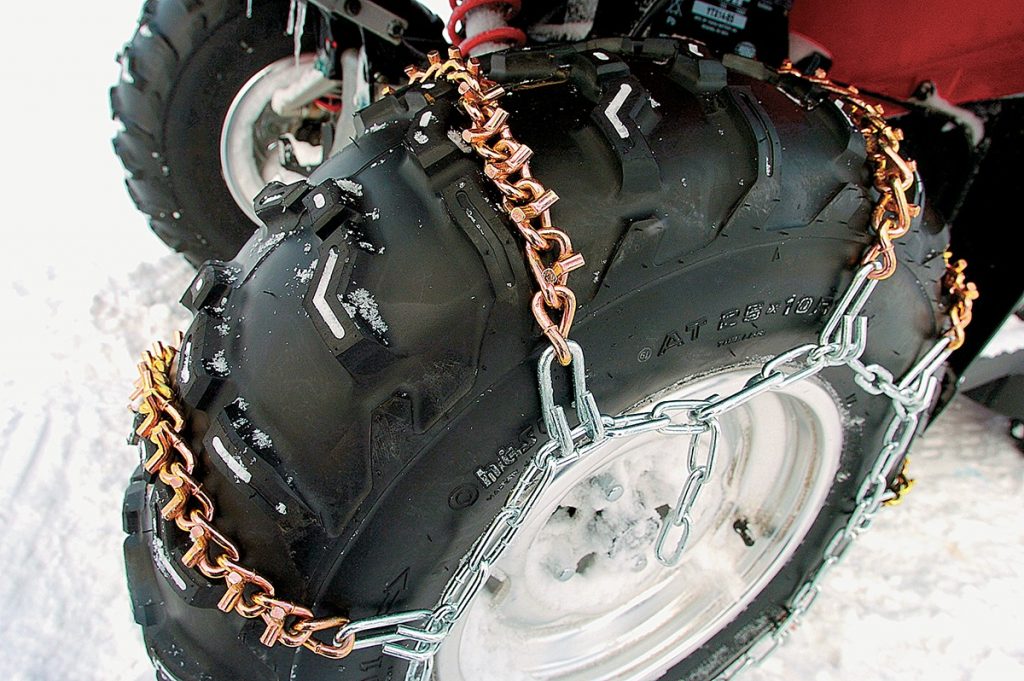
Driving with snow chains on your tires is a great idea when the roads are covered in snow and ice. But will snow chains make your car slower? How fast can you drive with snow chains?
With snow chains on your tire, you should drive your car not more than 20 to 30 miles per hour (30 to 50 kilometers per hour). Even if you want to, your car will not be able to drive at its normal top speed on a snowy road with chains on the tire.
You should not try to drive faster than about 20-30mph with snow chains. If you go over a dry patch of the road, the chains can cause your car to slide out of control when steering or braking.
It is important that the snow chains are fitted properly on your tires. If not, your tires will develop minor cosmetic damage, especially if you speed up the car. Be safe and keep your speed below 30 mph when driving in snowy weather.
Read on to learn more about how fast you can drive with snow chains on and tips for driving safely with snow chains.
Snow chains can be used up to 20-30mph (30-50km/hour). It would be difficult to drive faster than this in snowy conditions with snow chains, even if you want to. The traction on the snowy road prevents your car from going too fast.
Snow on the road and tire chains on your tires is not a normal driving condition. This situation negatively affects the fuel efficiency of your car, as well as its speed.
For your safety, you are required by your state authorities to use snow chains on your tires when driving on roads and streets under heavy snow.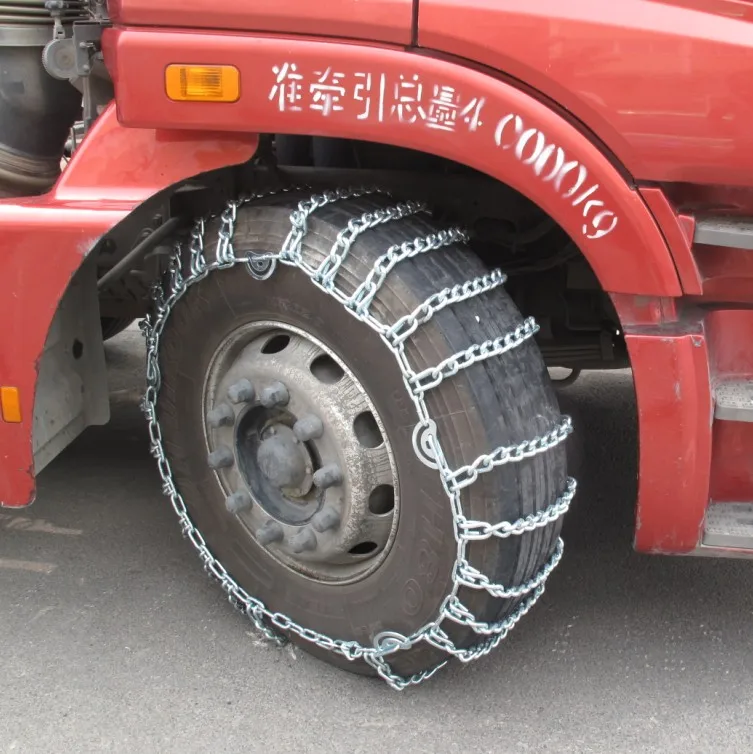 During such conditions, the fastest that you can go is no more than 20 to 30mph. Any faster than 20 to 30 mph with chains can cause your car to slide out of control when braking or steering.
During such conditions, the fastest that you can go is no more than 20 to 30mph. Any faster than 20 to 30 mph with chains can cause your car to slide out of control when braking or steering.
There are car models that give specific details on how fast they could go on roads heavy with snow. But 20 to 30 mph. should be the average speed limit you should observe regardless of your car’s type and make.
The main reason why you are using snow chains is that the road condition is bad. The snow that is continuously falling makes it difficult for the road crew to keep up. The condition is already forcing you to drive slowly.
If you’re confident that you have properly installed the tire chains and that they won’t fall off, then you could drive normally. But ‘normally’ means normal speeds in snowy weather, not in sunshine conditions.
If you drive faster than 30 mph on snowy roads, you risk damage to the chains, tires, and your car. When the weather is so poor, making chains necessary for driving, you can’t drive faster than 35 mph.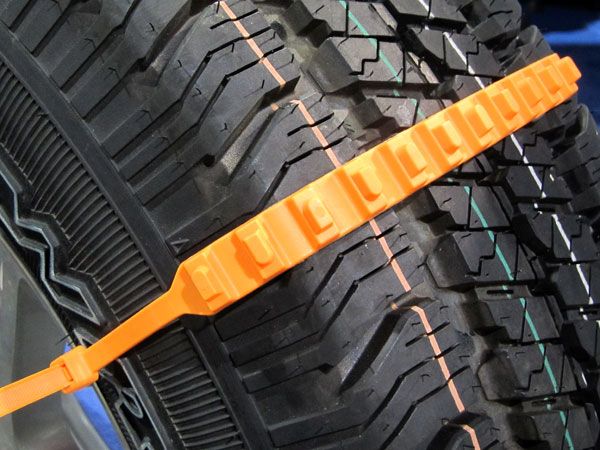
Below are some of the things that will limit your speed, even if your tires have chains in snowy roads and streets:
If the snow on the road is already compacted, you can drive at a fairly fast speed but not too fast. But if there’s a fresh layer of snow on the road, you have to drive more slowly.
If there’s a tight fit in the snow chain and the tire, there will be more grip on the road, and you can drive faster. But if it’s a loose fit, you have to drive slower. Be sure to use the right chains for the size of the tires.
The newer the tire chain, the more confident you will be in using it, and the faster your car can go. The reverse will be true if you are using an old tire chain.
If this is your first time using a snow chain, you will tend to go slow. After using it several times, you will be more confident, and thus, be able to drive faster.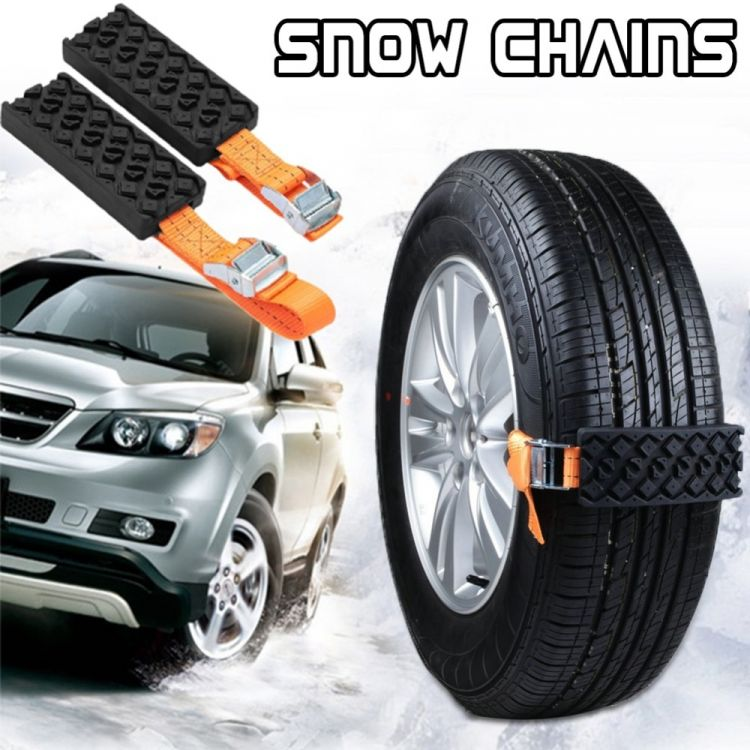
To some extent, the tire chain’s design can affect your speed while driving in the snow. Some snow chains cover the entire tire tread and tire walls, while some only cover part of the tire tread.
Snow chains can get you out of difficult situations in snowy weather, but not if you drive too fast. The main reason why tire chains are used is to give you a safe way to travel an unsafe road. Dangerous road conditions mean extra care in driving your car.
Here are some safety tips when you’re driving with snow chains:
Before installing the tire chain, see to it that the tires are properly inflated. There should be at least three millimeters of tread in it. Better yet, use winter tires if you have them.
See that your brake locks are working and not frozen. If they are frozen, spray some WD-40 until they thaw. Bring along a shovel just in case you bog down on the snow.
You will destroy the tire chain, your tires, and the road your car is running on. That means after you have gone through an icy road and ahead is a road cleared of ice and snow, you don’t have to drive with chains.
You can use just one pair of tire chains, but it is better to use two pairs for better traction and grip. If only one pair is used, the snow chains are installed on the driven wheels.
Using only one pair will either cause your car to understeer or oversteer. If you have four-wheel drive, you need to cover all your tires with snow chains.
So if you have a front-wheel car, install the chains on the front wheels. Your car will oversteer if you put the chains only on the front wheels.
If yours is a rear-wheel drive, but the chains around the rear wheels. Your car will understeer if you put the chains only on the rear wheels.
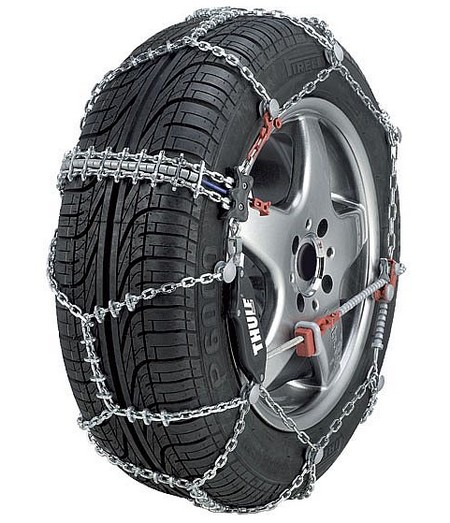 Turn Off Traction Control/Anti-skid
Turn Off Traction Control/Anti-skidIf your tires are already covered with snow chains, turn off the car’s Traction Control/Anti-skid safety feature. To be sure, check your car operator’s manual.
After installing the chains, don’t drive right away. Start the engine and gently shift from neutral to gear 1 (or Drive, if automatic) and drive slowly. After a short distance, stop and check the fit of the chains.
Adjust them if necessary so that they are securely fitted on the tires. They shouldn’t slip from the tires while your car is running.
Keep your speed down and minimize sudden jerks on the steering wheel. Be particularly careful when negotiating bends and curves. Don’t step on the gas and the brakes abruptly. Drive as gently as the outside conditions allow.
After using the chains, check if there are parts that are damaged during your trip.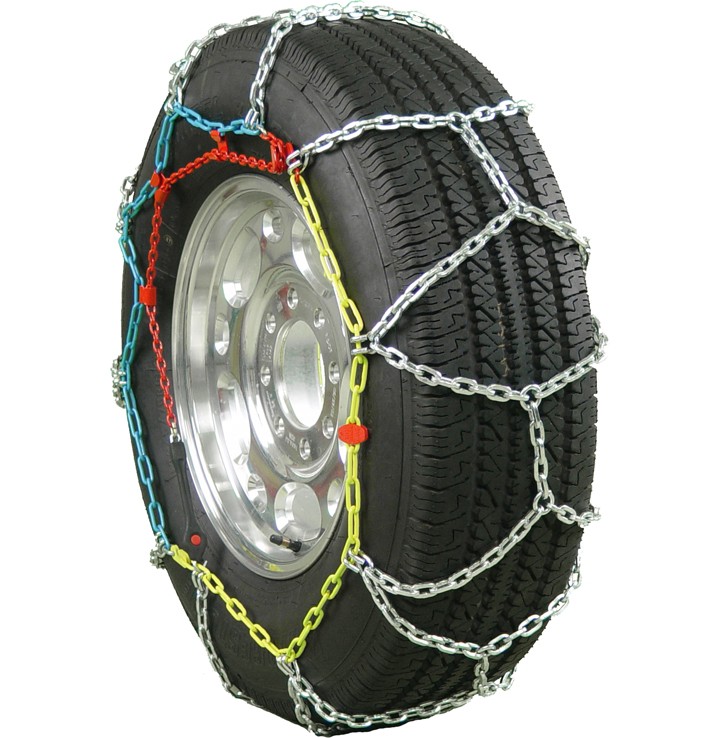 Look for links or connectors that are broken. Repair them if possible. If not, replace them with a new one.
Look for links or connectors that are broken. Repair them if possible. If not, replace them with a new one.
Clean and dry the snow chains before putting them in storage. Chains made of metal can corrode. It is important to get them dried completely before they are stored.
Again, how fast can you drive with chains? Your car can go as fast as 20 to 30 miles per hour (30 to 50 kilometers per hour) when it is equipped with snow chains. You won’t be able to drive much faster on snow and ice.
Don’t expect that you can normally drive; rather, expect that your speed will be reduced. Don’t try to drive faster than about 30mph, as this can cause your car to slide out of control.
If you drive too fast while your tires are wearing snow chains, you will cause minor damages to them. You can minimize the damage to the tires if you limit your speed below 30 mph.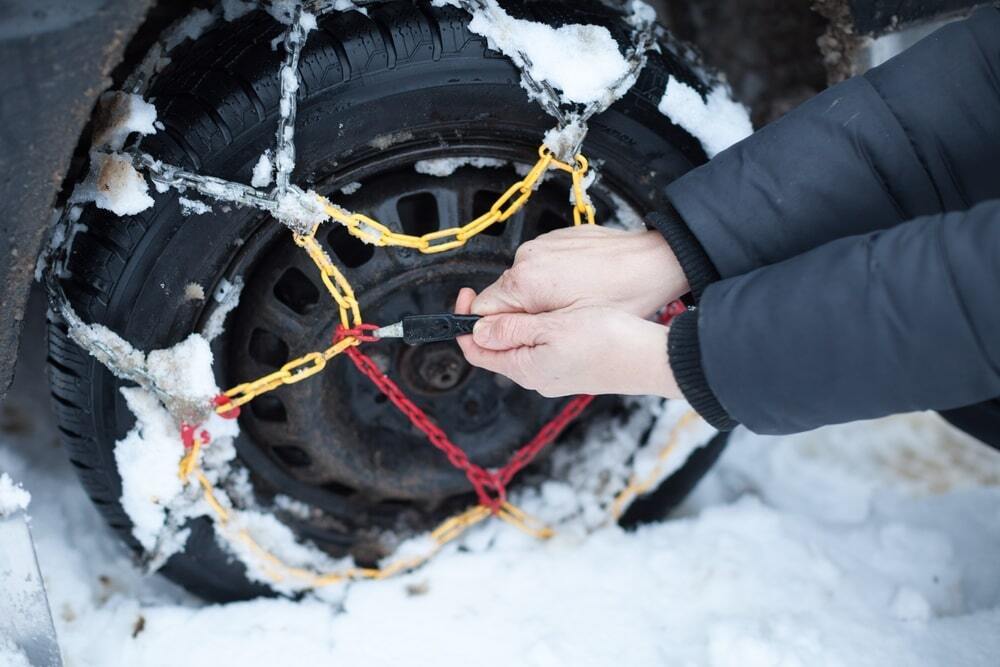
And if you drive your car too fast and one of the tire chain snaps, it will damage your car’s body or chassis. The chain may even get entangled with the shock absorber and other parts of the car under the chassis.
Yes, it could, so be prepared when you are driving on snow. It is frightening to have your car skidding. When this happens, try to remain calm and decide where you want the car to go.
Here are some steps you can do when this happens:
Don’t slam on the breaks but steer the car gently in that direction. This can happen when you are running at 35 mph or more.
Slow down to keep your car from hydroplaning. Take your time before driving straightaway after a snowfall or rainfall. The road is slippery so wait until everything has settled before driving away.
Hold the steering wheel tightly with both your hands.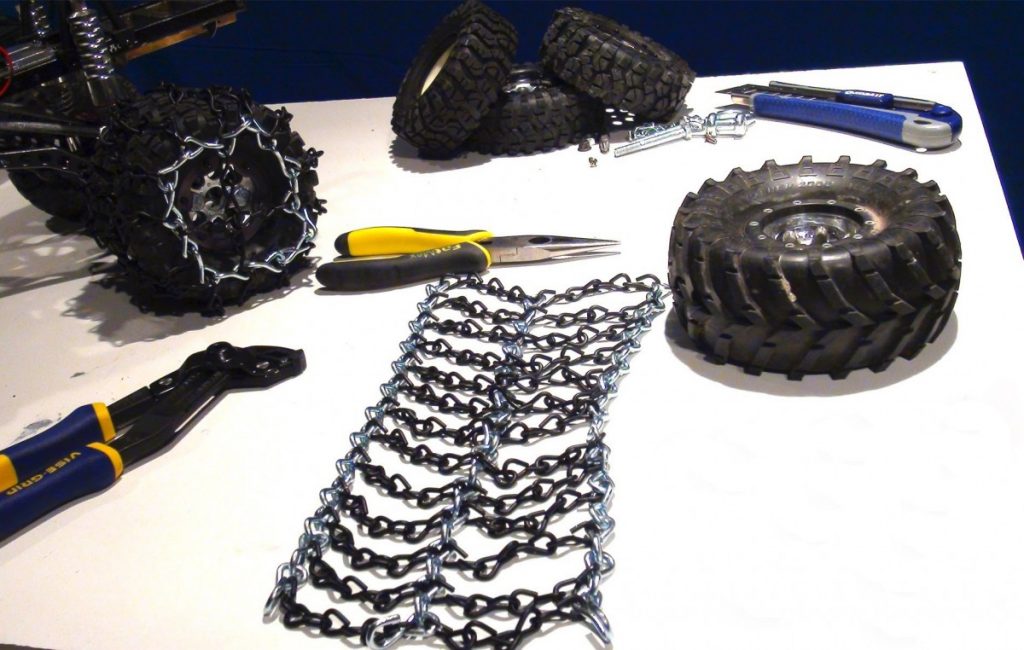 The road is influencing how your car is turning, but you can control it by keeping a solid grip on the steering wheel.
The road is influencing how your car is turning, but you can control it by keeping a solid grip on the steering wheel.
It is when you are approaching or negotiating a bend that skids often happen. So be slow when you are nearing a corner.
Turn off your car’s cruise control when traveling on snow. Cruise control under snowy conditions can lead to skidding or hydroplaning. You can’t shift the car’s weight when it is in cruise control, and it can easily lose traction.
The snow chains must be fitted securely on the tires. If not, they can fall off when you are driving fast. It would help if you practiced how to install the snow chains on your tires. It is relatively easy to do. In installing the chains, use a pair of gloves and a pair of tire tensioners.
Here are the steps you can follow to do this:
Get the chains from the pack or box and make sure that the chains are straightened out and not looping over one another.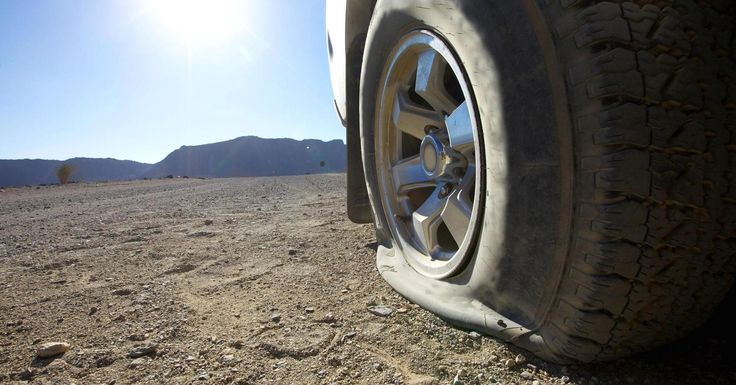 Hold them up so that one end is in your right hand and the other end is in your left hand.
Hold them up so that one end is in your right hand and the other end is in your left hand.
You should see the metal latches along the two sections of the chains. The latches and hooks of the chains are usually color-coded to help you connect the same colors together.
You should connect them in such a way that they will not cause any damage to your tires. To be sure, follow the instructions on the chain pack or box.
Lay the chains on the ground in front of the tire. The latches should be on each side of the tire. The tires should not run over them.
Start the car and drive it forward so that the chain is directly under the tire. Stop the engine and cover the tire with the tire chain. Connect the latches on either side of the chain.
If you need to turn the wheel toward the inside of the car, you can easily access the chain’s connecting points inside the wheel.
If you install the chain on the right tire, turn the steering wheel on the left and vice versa if you install the chain on the left tire. Put the car on the parking brake so that it won’t move forward or backward.
Put the car on the parking brake so that it won’t move forward or backward.
Connect the hooked edges of the chain in the inner part of the tire. Then connect the hooked edges on the outside section of the tire.
Rotate the tightening cam or closing link so that the chains will be tight enough. This will ensure it won’t slip from the tire when the car is running. Make sure that the links of the chain are evenly distributed throughout the tire.
It would help if you only covered your tires with chains when traversing a road-heavy laden with snow. Using it unnecessarily will damage your tires and your car, and the road you are traveling on. Using a snow chain that is not suited to your tire’s size will also damage your tires.
Your car should go about 20 to 30 mph (30 to 50 kilometers per hour) with snow chains on the tires.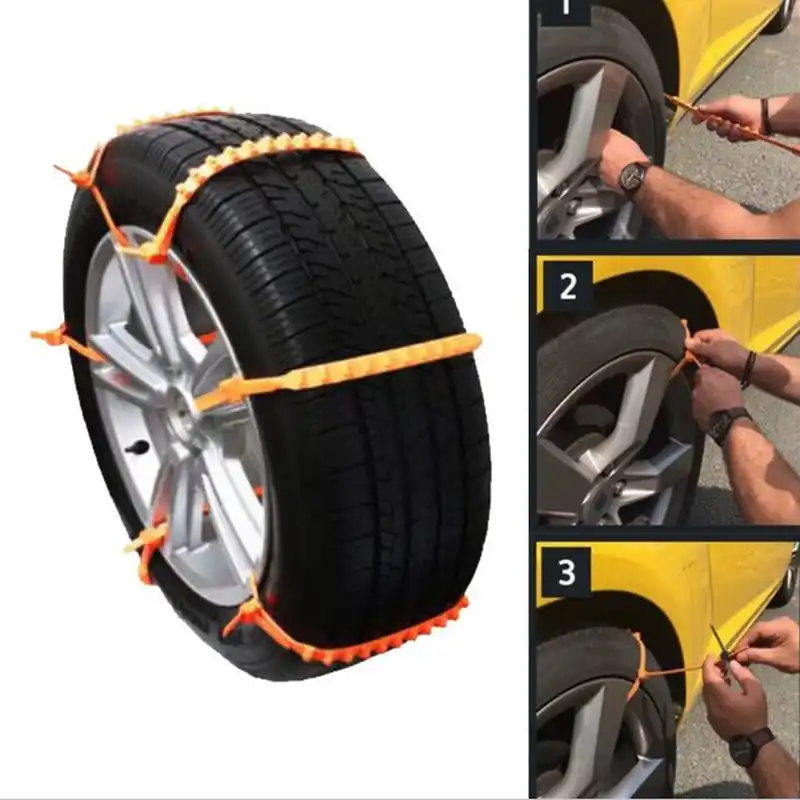
Don’t make the mistake of thinking that you can normally drive with snow chains on your tires. When your tires are wearing snow chains, you will notice that your car will not be able to reach its top speed.
If you drive over a dry spot of the road with snow chains, your car can slide out of control when braking or steering.
Be safe and keep your speed below 30 mph. when driving in snowy weather.
Related reading:
How to Drive in Snow Safely [9 Tips]
How to Put on Snow Chains? [Easy Snow Chain Install]
How to Put Chains on Tires
Snow Tires Vs Chains – Which One Should You Choose?
Differences Between Snow and All-Season Tires
In this article we will look at the use of snow chains. We will find out what types of chains are, how to put them on wheels and how much they cost.
Automotive snow chains are something like a replaceable tread that makes it possible to turn an ordinary road tire into an icy or off-road tire.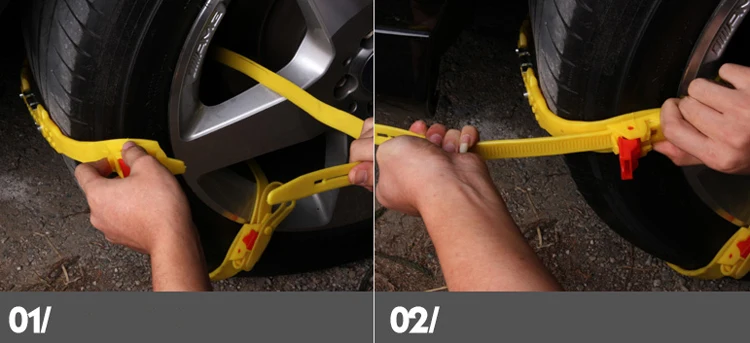 Structurally, this anti-skid chain consists of two longitudinal chains or cables - external and internal, passing along the circumference of the wheel, which are connected by transverse chains or rubber "lugs", which significantly increase the grip properties of the wheels (and, accordingly, the vehicle's cross-country ability) on ice, on loose snow, deep mud, etc. In practice, it may look like this. You go fishing - you drive 100 km along the asphalt surface on ordinary tires, and then turn into a country road, where the very “hard off-road” begins. Then snow chains are put on - and you can go further, having much less chance of skidding or getting stuck in the mud. And such places as, for example, icy steep slopes, are very difficult to overcome without snow chains, even on studded tires.
Structurally, this anti-skid chain consists of two longitudinal chains or cables - external and internal, passing along the circumference of the wheel, which are connected by transverse chains or rubber "lugs", which significantly increase the grip properties of the wheels (and, accordingly, the vehicle's cross-country ability) on ice, on loose snow, deep mud, etc. In practice, it may look like this. You go fishing - you drive 100 km along the asphalt surface on ordinary tires, and then turn into a country road, where the very “hard off-road” begins. Then snow chains are put on - and you can go further, having much less chance of skidding or getting stuck in the mud. And such places as, for example, icy steep slopes, are very difficult to overcome without snow chains, even on studded tires.
Snow chains are divided into two classes: “hard” and “soft”. The former use the chain itself as cross members, while the latter use reinforced rubber “lugs”.
There are two basic types of pattern: "ladder" and "rhombus/honeycomb".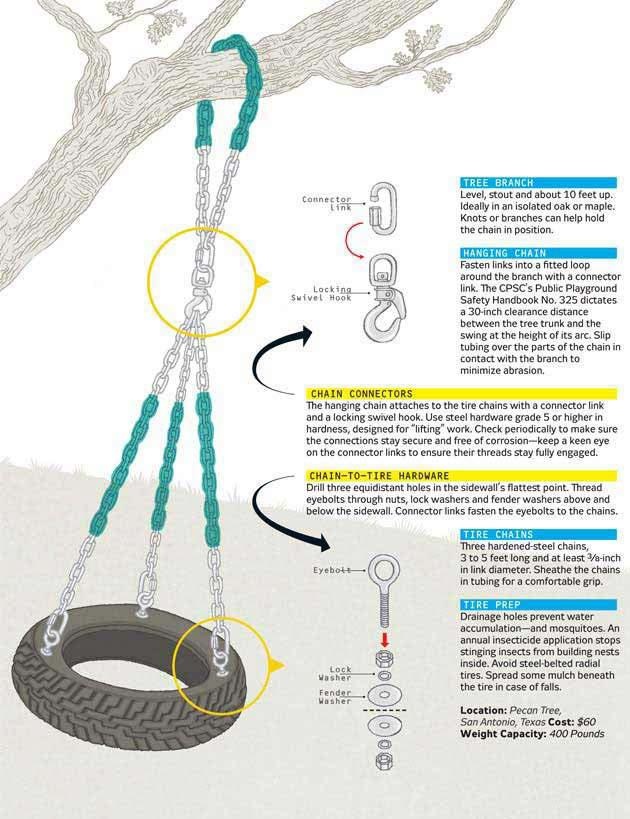 In the first, the longitudinal chains / cables are connected with straight transverse pieces, in the manner of a rope ladder. In the "rhombus" they are connected obliquely, getting a "spider" pattern. Snow chains differ in the size and shape of the links (or lugs). Snow chains are made of various materials such as steel, titanium (very expensive), aluminum and reinforced plastic. Sometimes chains are additionally reinforced with metal spikes.
In the first, the longitudinal chains / cables are connected with straight transverse pieces, in the manner of a rope ladder. In the "rhombus" they are connected obliquely, getting a "spider" pattern. Snow chains differ in the size and shape of the links (or lugs). Snow chains are made of various materials such as steel, titanium (very expensive), aluminum and reinforced plastic. Sometimes chains are additionally reinforced with metal spikes.
It is impossible to say which snow chains or which pattern is better. Since it all depends on the conditions where they are used. So, “hard” chains are better suited for off-road than “soft” chains, but they do not allow you to move at speeds over 50 km / h. "Soft" ones make it possible to move at speeds up to 80 km / h and wear out rubber much less than "hard" ones. Therefore, for those who left the highway and went to knead deep off-road, the “hard” option is better. For those who drive where sections of flat roads and muddy snow constantly alternate, “soft” chains are more suitable.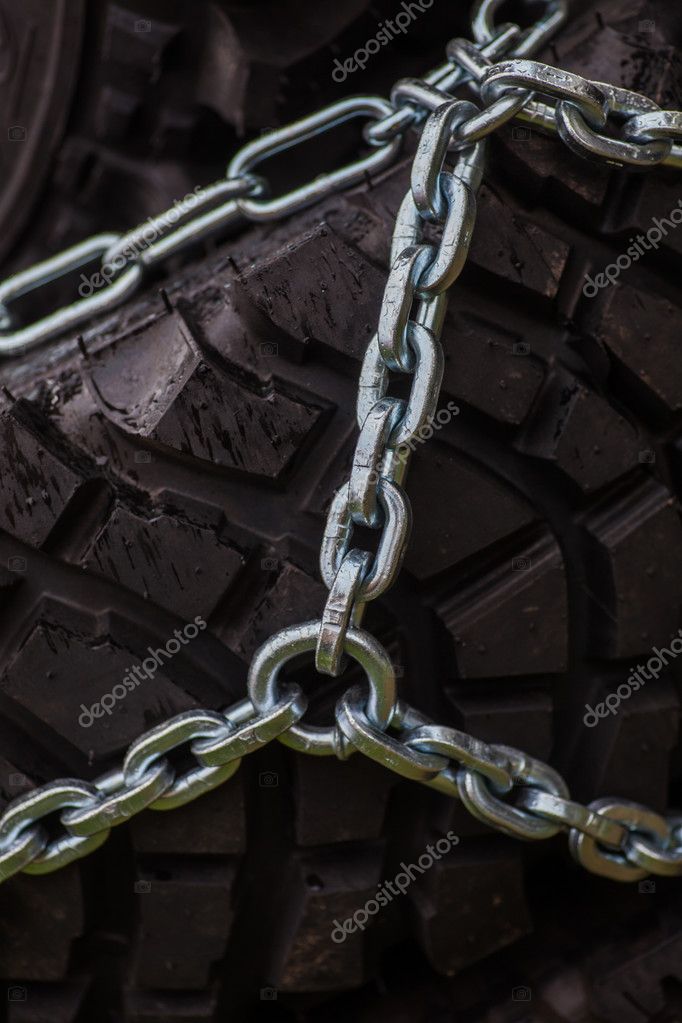
The same can be said about the dimensions of the chain links. The larger the link, the higher the off-road performance, but more weight, worse driving on a flat road and more tire wear.
Driving with chains. What cars can chains be put on.
When it comes to car brands, snow chains can be used on virtually any car. In addition to some sports, purely track cars. If we talk about tires, then here it must be said that “hard” chains are not suitable for low profile tires. But "soft" can be used.
Snow chains also differ by vehicle class, for cars, SUVs and trucks. But here the wheel size plays a role, first of all: the chain covers from two to four standard sizes along the radius. In addition, for SUVs and trucks, chains are made with large links, often with additional spikes.
It is not necessary to install snow chains on all wheels of the car - it can only be installed on the drive axle. This is useful when driving on not very off-road, when used from time to time, as well as to overcome problem areas of a country road.
Driving with chains. How to put on chains.
In order to put snow chains on the wheels of a car, they are laid out in front of the wheels of one axle exactly along the axis of motion, so that the locks on the outer side chain come out to the outside and face forward. The rear side chain hook must be on the inside. It is necessary to run the wheels on the chains so as to stop 20-30 cm from their end. After that, put most of the chain on the wheel and hook the hook from the inside. Then you need to straighten all the links on the wheel (for “soft” ones, put on the adjusting cable / chain), and then hook the lock of the outer side chain. It is necessary to “roll” the chains, after driving 10-50 m, so that the chain settles down, and then tighten the locks again.
Experienced drivers put on the chains in five minutes, and for them it is no more difficult than tying their shoelaces. But for many motorists, especially beginners, putting on snow chains turns out to be the main “stumbling block”, and there are many who refuse to use them precisely because of this procedure. In any case, before using the chains, you should first practice putting them on somewhere on a dry site, then it will be easier on the road.
In any case, before using the chains, you should first practice putting them on somewhere on a dry site, then it will be easier on the road.
As for tire wear, it should be noted that all chains wear rubber quite a lot. “Hard” more, “soft” less. Wear also depends on the frequency of use of snow chains. The rubber actively begins to “eat up” when driving “in chains” on a hard road for a long time, sharp braking and acceleration, with too little contact between the chains and the wheel.
With regard to the safety of driving a car with chains, here the danger is the violation of operating instructions and faulty chain locks. When riding with chains, you must not exceed the speed prescribed by the instructions for the chain. In this case, under the action of centrifugal force, the chain may come off the wheel and hit the wheel arch or break the tire. In the worst case, if the chain lock breaks, it can catch on suspension parts (for example, on the arm), which can lead to serious damage and even an accident. The condition of the links, locks and the reliability of fastening must be carefully checked before using the chains.
The condition of the links, locks and the reliability of fastening must be carefully checked before using the chains.
Snow chains. Where to buy and how much do they cost?
Snow chains are easy to make, which is why so many metalworking companies make them. Of the well-known foreign brands, one can name such as RUD (Germany) and Pewag (Austria). From Russian - "Metallist" and "Red Anchor". The average price of a set of two snow chains is $200-250 for a passenger car and $250-300 for an SUV. Although in the automotive markets, you can easily find cheaper chains of both Chinese and our production.
Snow chains video
Chain testing videos.
UAZ on snow chains.
Zhiguli with chains, video:
Chevrolet Niva in the snow on chains.
Video: putting a chain on a car.
Tags: riding with snow chains.
Tires of the same size may vary from manufacturer to manufacturer, especially mud and snow or off-road tread tires, so no snow chain online store can indicate the correct size of the chains with a 100% guarantee. If the chains are installed with great effort, it is better to change the size.
Most snow chains are now easy to install, however we strongly recommend that you practice putting them on dry before you encounter installation in snow or mud when purchasing.
How much clearance is required for snow chains?
Clearance is the amount of space between the wheel and any obstructions such as the body, brake systems or suspension of the vehicle.
Standard 9mm automotive chain needs about 15mm between the inside edge of the tire and any obstacles (to keep the chain moving), standard 4x4 chains can protrude 16mm from the wheel and so need a minimum clearance of 21mm.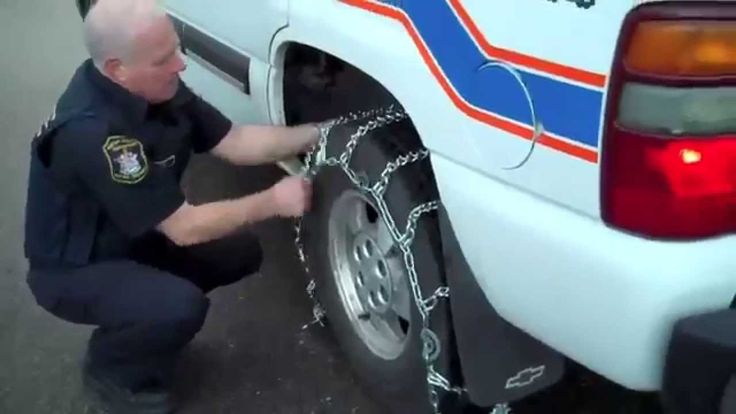
Snow chains are sold in pairs and must be fitted to the drive wheels. This is generally considered sufficient and meets legal requirements on mainland Europe and European mountain roads. For some vehicles, four snow chains are recommended.
What are the best snow chains for a rear wheel drive vehicle such as a BMW or Mercedes?
Although one set of chains will meet legal requirements on snowy roads in continental Europe, rear wheel drive vehicles may be difficult to drive on snow and ice. The chains must be fitted to the rear wheels, meaning the steering wheels are left without enhanced traction. Additional complications may arise when the vehicle is heavily loaded in the trunk and therefore it may be advisable to install a second set of chains (if clearance permits).
By law, when driving in mountainous areas, it is only necessary to have snow chains for one axle. However, when driving 4 x 4 Some drivers prefer to use 4 chains (two sets). While one set of chains will provide sufficient traction in most conditions, there are significant benefits to using two sets. It is important to refer to the vehicle owner's manual as some manufacturers recommend two pairs.
However, when driving 4 x 4 Some drivers prefer to use 4 chains (two sets). While one set of chains will provide sufficient traction in most conditions, there are significant benefits to using two sets. It is important to refer to the vehicle owner's manual as some manufacturers recommend two pairs.
Some vehicles have very little space between the wheel and the vehicle's suspension or other obstacles, which means the chains can come into contact with the body, brakes or suspension with serious consequences. You can check if your car has a clearance problem by placing your hand in the wheel arch, on the tire, and feeling around the tire for obstacles that are approaching it, especially the back/inner wall of the tire. Move your hand from 915 hours along the back/inside of the wheel to check the distance between the wheel and any obstructions. Keep in mind that the chain sits on the rubber of the tire, so any obstacle that comes close to either side of the tire can be a problem.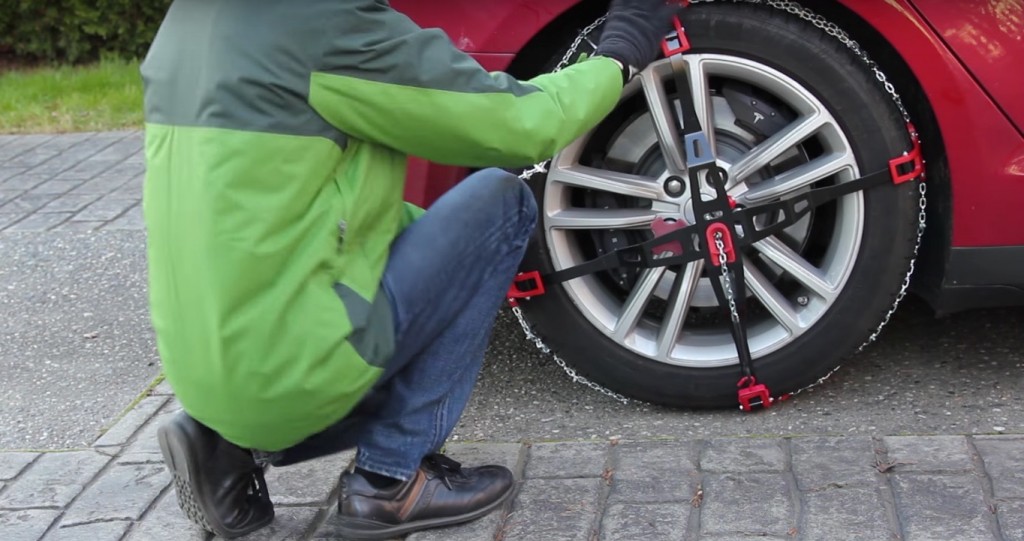 You also have to consider the proximity of the wheel arches when turning the steering if you are coming up to the front wheels, usually the compression point is at 3 or 9 o'clock at the back of the wheel when the steering is locked. (Check by locking the steering and placing your hand at the compression point to gauge the proximity of the arch to the tire, and do the same for the opposite lock.)
You also have to consider the proximity of the wheel arches when turning the steering if you are coming up to the front wheels, usually the compression point is at 3 or 9 o'clock at the back of the wheel when the steering is locked. (Check by locking the steering and placing your hand at the compression point to gauge the proximity of the arch to the tire, and do the same for the opposite lock.)
For 16mm chains you need at least 21mm of clearance. Western manufacturers offer 7 mm chains for cars with insufficient clearance.
Belarus, Russia, Italy, Iceland, Serbia, Montenegro, Slovakia, Finland, Estonia do not regulate the use of chains.
But be careful if you are traveling by car in Europe, Canada, USA.
Prohibited for use in Denmark, the Netherlands. (Information may change over time, so it's best to double-check.)
In France and Switzerland there are no strict requirements for winter tires. Permitted in case of ice or deep snow in Belgium, Great Britain, Greece, Ireland, Lithuania, Latvia, Luxembourg, Sweden, Norway. Also, in most European countries, chains are required if there is an appropriate road sign.
Permitted in case of ice or deep snow in Belgium, Great Britain, Greece, Ireland, Lithuania, Latvia, Luxembourg, Sweden, Norway. Also, in most European countries, chains are required if there is an appropriate road sign.
For example, in Austria snow chains are allowed as an alternative to winter tires on drive wheels. The fine for driving on summer tires from November 1 to April 15 can reach 5,000 euros.
From the beginning of 2018, in Europe, a winter tire must bear the 2012 "Alpine symbol" (Three Peak Mountain Snow Flake) to be considered a winter tire. The M+S symbol is only valid for tires with an earlier release date, and then only until autumn 2024.
Twenty-two of the 47 European countries have strict requirements for the use of tires on commercial vehicles in winter conditions, and a growing number of local regulations mention the 3PMSF label.
Mandatory presence in the car from November to April: in Albania, Bosnia and Herzegovina, Bulgaria; Hungary, Macedonia, Slovenia, Croatia.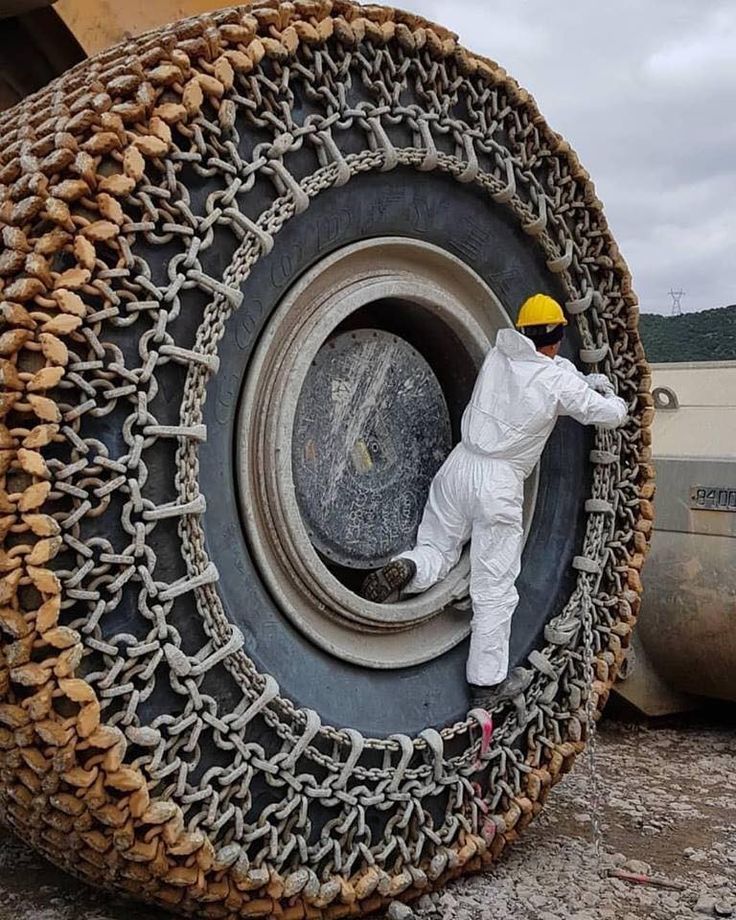 Chains are obligatory if the weather conditions require it: in Romania, Andorra, Austria, Macedonia, Bulgaria, Hungary, Germany, Spain, Poland, Portugal, France, Czech Republic, Switzerland.
Chains are obligatory if the weather conditions require it: in Romania, Andorra, Austria, Macedonia, Bulgaria, Hungary, Germany, Spain, Poland, Portugal, France, Czech Republic, Switzerland.
Some US states and Canadian provinces also require drivers to carry snow chains.
In general, in mainland Europe, the driver is responsible for equipping his car for all weather conditions. The driver can be fined if he does not use snow chains when they are needed, thus obstructing the normal flow of traffic or provoking accidents.
Snow chains are required by law on all European mountain roads. Roadside checks are being made and drivers can be fined if they don't have the kit in their vehicle.
European standards recommend driving with caution in snowy conditions at speeds not exceeding 30 miles per hour (48 km/h). When driving on mud, on hard surfaces, and even more so on paved areas, the speed must be limited more strongly and regulated, based on safety and tire safety considerations.